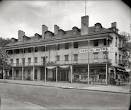St. Charles Hotel, 1820-1926
Introduction
Text-to-speech Audio
Images
The Fugitive Slave Act. Photo credit to commonconstitutionalist.com.

This image shows the New Capital Hotel, which was built from the remains of the St. Charles following a fire in the late 1800s.

Backstory and Context
Text-to-speech Audio
The St. Charles hotel was the location of many important meetings between political leaders when they traveled to Washington, as it was once one of the city's most exclusive hotels. The hotel included a "special feature" to accommodate Southern planters and politicians whom might travel to the city with their human property during the 1850s when it included slave pens in the hotel basement. These underground cells included iron doors and iron rings embedded in the walls.
Following the end of the Civil War, the hotel experienced increased competition, with many guests choosing the Ebbitt House, Riggs House, and Arlington Hotel over the St. Charles. During the 19th century, the St. Charles Hotel accommodated a diverse number of Americans, albeit under circumstances that reflected rather than challenged the era's lack of equality. Enslaved men and women who worked as personal servants might stay in the rooms upstairs, but only so long as their proximity to their masters was desired. Likewise, Native American leaders were also provided with accommodations at the hotel, but only because Congress needed a place for these men to stay while they were in the capitol city to negotiate and sign treaties.
The hotel was partially destroyed by a fire in the late 1800s. In the effort to rebuild the structure, the hotel's distinctive main entrance was removed. After the hotel was rebuilt, it was also renamed the Capital Hotel. The name was changed twice more, becoming the Hotel Belvedere, and eventually the New Capital Hotel. The reconstructed building was razed in 1926.
Cite This Entry
Bias, April et. al. "St. Charles Hotel, 1820-1926." Clio: Your Guide to History. September 4, 2016. Accessed April 5, 2025. https://theclio.com/entry/25967

